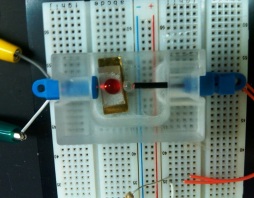Researchers from the University of Arizona have shown a way to significantly simplify testing patients for infectious diseases and unbalanced levels of proteins. The innovative test equipment developed by the researchers promises to make the procedure less expensive and faster

Researchers from the University of Arizona have shown a way to significantly simplify testing patients for infectious diseases and unbalanced levels of proteins. The innovative test equipment developed by the researchers promises to make the procedure less expensive and faster.
The current test methods are slow and expensive due to the problems of handling blood samples, saliva, urine and other biological fluids, says the lead researcher, a professor in the School of Health Systems Engineering and Biology at the University of Arizona. Such samples "are complex mixtures that require the use of advanced equipment capable of mixing the sample with antibodies or other biological reagents in order to obtain an accurate positive or negative reaction," explains the researcher.
The researchers were able to develop a test method that allows testing the patient's own sample through a reaction with a basic and cheap test device. The method uses light emitting diodes (LED) and simple microelectronic amplifiers rather than advanced and more expensive technological means such as lasers and robots.
The researchers showed that superhydrophobic surfaces are able to turn blood, saliva, urine and other liquids into round droplets. These droplets are capable of focusing light and mixing quickly as well as moving micro- and nano-particles that can be analyzed to detect a specific infectious agent or protein. "Superhydrophobicity" is the property of materials to repel water, such as duck feathers or the leaves of the lotus plant. Such materials are used commercially in fabrics, building materials and surface coatings.
The new device works by placing a drop of nanoparticles or microparticles in a drop of the patient's liquid sample over a super-hydrophobic surface. The surface has tiny dimples that hold the sample liquid in place to receive a spherical drop.
The drop behaves like a lens due to its surface tension. A light emitting diode radiates light towards the drop and the shape of the drop focuses the light into a powerful beam which is measured by a second diode. Since the drop evaporates slowly, the researcher explains, the nanoparticles begin to stick together quickly when the patient's liquid sample contains the infectious substance or the protein being tested. The infectious substance or protein migrates to the center of the droplet, obtaining a situation where the other particles move towards the surface. This phenomenon leads to internal mixing which speeds up the diagnostic process so that detection occurs in less than two minutes.
Since the liquid sample integrates with diodes and microelectronic components, the researchers call their innovative device the Integrascope.
The researchers built several prototype devices based on the above design and showed how the device is used to test the presence of the protein known as "C Reactive Protein" in a human blood sample, a protein that is a sign of many inflammatory conditions when its level in the blood is high. High levels of protein may indicate cell or tissue damage, inflammation, disruption of kidney function, or the immune system producing more and more antibodies in response to infection or an autoimmune disease. Low levels of protein may indicate malnutrition, or the presence of diseases that prevent the body from producing enough blood proteins. The device can also be used to obtain an index of a person's general health, thanks to the measurement of the total amount of proteins in the blood, saliva and urine.
The development of the device was based on a surprising discovery that occurred during the researcher's doctoral thesis, while he conducted an experiment in which he aimed a light-emitting diode at a drop located on a super-hydrophobic surface. He tried to see if he could notice changes in the emitted light as a result of the presence of protein in the liquid. "To our surprise," said the lead researcher, "we immediately realized that his laboratory arrangement created a very powerful light beam that could be easily measured using a fiber optic light detector that we had in the lab."
The research findings were published on the website of the scientific journal Nature Precedings. The article describes how the new device works and details the information provided by the diagnostic test in a few minutes.
The most common inexpensive devices on the market today use lateral-flow immunoassays that are similar in form and function to the home pregnancy test kit.
The main obstacle in the production of cheap diagnostic devices for many conditions and diseases using the above method is that the sensitivity has to be compromised against the selectivity. Another approach to the miniaturization of complex devices suffers from the difficulty of reducing the cost to a level that most consumers will be able to handle - about $2-1 per kit - as well as the need for spare parts and their special handling. "In order for them to have a global impact, we need accurate and sensitive tools that can help healthcare providers treat patients at a low cost even during their first visit," explains the researcher.
"Our goal is to translate this technology and design into an available and usable device that we can provide for free to clinics. The only cost of our new device will include the particle droplet and a small piece of superhydrophobic surface - only 1-2 dollars," explains the lead researcher.

One response
The invention sounds brilliant.
If indeed it does what they say it does and its costs are indeed as they say, it may be a world revolution - no less.